Hamburg-Sued
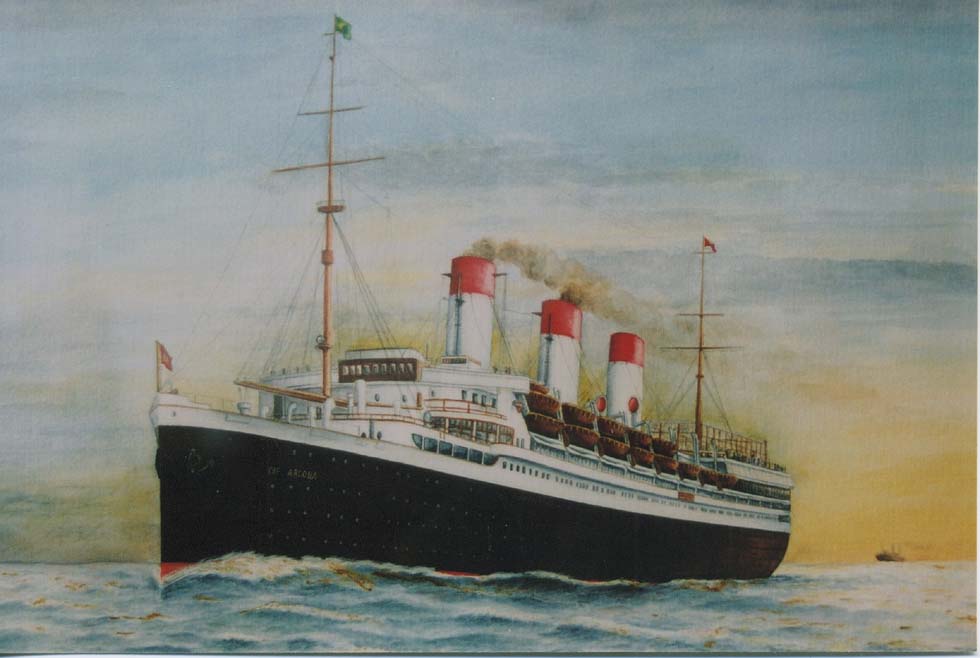
"Cap Arcona" (painting by Heribert Schroepfer)
German South American Operations
The failed revolution of 1848/49 for a unified democratic Germany, the following persecution of so-called Demagogues and the suppression of any freedom movement produced a wave of emigration, mainly to the United States, but also South America won on interest. Paying attention to this movement, four businessmen founded in 1855 the Hamburg-Brasilianische Dampfschiffahrts-Gesellschaft. The young company had to withstand hard competition from the start. Among the seven internationally operating companies having been engaged in the South American business, only the Royal Mail of Great Britain survived. The Hamburg-Brazil Line opened a connection to Rio de Janeiro via Southampton, Lisbon, Pernambuco and Bahia with the steamers "Teutonia" (2,248 gt) and "Petropolis" (2,405 gt), delivered from Caird in 1856. A planned feeder-line to the River Plate ports got never into operation and the delivery of a third ship with the name "Prinzessin von Joinville" (2,500 gt) had to be cancelled.
Fourteen years later, in 1869, a new attempt for a South America steamship connection from Hamburg was started by the sailing-vessel owner August Bolten in cooperation with the shipbuilder firm Mitchell & Co. and the ship-owner Milburn & Co. of Newcastle, again under the name Hamburg-Brasilianische Dampfschiffahrts-Gesellschaft. Ports of destination were Rio de Janeiro and Santos with the small steamers "Santos", "Brazilian" and "Rio" (ex "Criterion"), sailing under British flag.
Hamburg-Sued
The foundation of the new German Empire in 1871 after the victoriously finished war with France and the powerful national economy of the united Germany paved the way for August Bolten to found the Hamburg-Brasilianische Dampfschiffahrts-Gesellschaft, which was to become the premier company of the South America traffic under the efficient management of the co-founder Heinrich von Amsinck. First ships of the new enterprise were the former Bolten steamers "Rio" (1,554 gt), "Santos" (961 gt) and "Brasilien" (ex Brazilian", 1,315 gt). The following year the service was extended to Argentina. The "Bahia" 1872 (2,000 gt) was the first to arrive at Buenos Aires. The successful operation required an urgent expansion of the fleet, thus the bigger "Buenos Aires", "Argentina", "Montevideo" and "Valparaiso" of 2,100 to 2,400 tons were added.
Around the change of centuries the Hamburg-Sued (abridged name generally in use) had to realize, that its ships could no longer compete with those of other nations being employed in the South America business, neither in technical dimensions nor in matters of comfort, owing to substantial subsidies, not to speak of the shorter routes to sail. Alarmed by the falling patronage, General Manager Theodor von Amsinck, son of Heinrich von Amsinck, initiated in 1896 the formation of a fleet of express steamers, setting a precedent for the decades to come. The new policy paved the way to the top position on the South America passenger trade, culminating in the famous "Cap" - steamers. As first to commence operation on the River Plate route was the "Cap Frio" (5,700 gt, 12 knots), built at the Reiherstieg Werft of Hamburg in 1900, followed by sisters "Cap Roca" and "Cap Ortegal" (7,800 gt, 13 knots, Reiherstieg Werft) and the "Cap Ortegal" (7,800 gt, 13 knots, Blohm & Voss), entering the line in 1906, "Cap Vilano" (9,400 gt, 15 knots) and "Cap Arcona" (I) (9,800 gt, 15 knots), each delivered from Blohm & Voss in 1907. The "Cap"-steamers were the first having painted their funnel yellow. A great step in advance has been the considerably bigger two-funneled "Cap Finisterre" of 14,503 tons, making 16.5 knots, built at Blohm & Voss in 1911.
A steady German competitor to the Hamburg-Sued had been the Hamburg-based company of A.C. de Freitas, which was absorbed in 1900 by the Hapag, the latter bearing in mind to participate in the profitable South America business. To prevent ruinous rivalry, Hamburg-Sued and Hapag agreed into an arrangement of a pool operation. The necessary tonnage was supplied by the first one at two thirds and by the latter at one third. The contract included also the Genoa - River Plate line of Hapag under the flag of Argentina, which necessitated the formation of a subsidiary company named Linea Nacional del Sud, Buenos Aires. First voyage was made by the "Comodore Rivadavia" (ex "Paraguassu") in 1911, followed shortly after by the "Itaparica" (ex "Chubut"). Yet in 1914 the contract between the two companies was dissolved, leaving the entire South American passenger trade to the Hamburg - Sued, which in countermove discontinued its Genoa - South America operation.
In expectation of a growing emigration movement to South America, the Hamburg - Sued placed in service eight units of the "Santa" - class between 1902 and 1907. These plainly appointed cargo/passenger ships of about 6,700 to 9,500 tons were exceptionally laid out for the conveyance of emigrants and season labour forces in between decks. Remarkably long-living was the "Santa Lucia" of 1907 (5,390 gt, 10 knots), who survived as "Joazeiro" of the Lloyd Brasileiro until 1955.
To serve the Brazilian Rio Grande coast, three 4,500-ton steamers commenced operation in 1905. Mainly provided for emigrant transport, appointments for 50 First Class passengers were arranged. On the River Plate route were further added the 11,500-ton steamers of the "Bahia" - class, conveying up to 2,500 emigrants and 200 passengers in the First Class. From 1910 the common schedule of the Hamburg-Sued and the Hapag offered weekly departures from Hamburg as well to Rio as to the River Plate, which remained unrivalled until being discontinued by World War I.
Serious rivals of the "Cap Finisterre" had been the British liners, matching her with dimensions and comfort and surpassing her in speed. But not enough of that: In 1912 the Compagnie de Navigation Sud-Atlantique of Bordeaux placed on the River Plate route the "Burdigala", the former "Kaiser Friedrich" of Norddeutscher Lloyd of 1898, having been sold to the French. The answer of the Hamburg-Sued was placing an order with the Vulcan for the 18,700-ton "Cap Trafalgar" to relieve the "Cap Finisterre" from the top position. This most elegant three-screw three-funnel liner, powered by two triple expansion engines working on the outer propellers and an exhaust turbine on the inner one, enabling her to manage up to 17.8 knots, only slightly less than the French competitor, entered the route in 1914.Berthing was provided for 1,574 passengers in three classes. To get another trump in hands, the Hamburg-Sued awarded contract for construction of a further, yet larger ship with Blohm & Voss, which took to the water in March 1914. Measuring 20,576 tons, the "Cap Polonio", being expected to become the new premier ship on the river Plate itinerary, providing accommodation for 1,556 passengers, 674 of which in saloons and cabins, was designed to the experienced principles and presented the last word both in comfort and in elegance, featuring a similar profile as the "Cap Trafalgar".
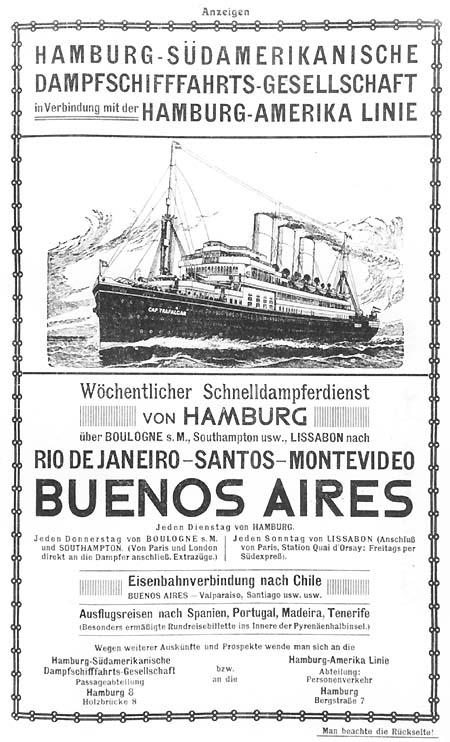 "Cap Trafalgar", Reichskursbuch Juli 1914 (coll. Josef Ungewitter)
"Cap Trafalgar", Reichskursbuch Juli 1914 (coll. Josef Ungewitter)
Hamburg-Sued hit by WWI
The luxuriously appointed premier ship "Cap Finisterre" berthing 720 passengers in the cabin classes only, was lying idle in Hamburg during the war. Thereafter she had to be delivered to the U.S. Navy. In 1920 she was handed over to the Toyo Kisen Kaisha as "Tayo Maru". Much worse came off the "Cap Trafalgar", which had been converted to an auxiliary cruiser off the German navy. By a surprise-attack from the British auxiliary cruiser "Carmania" she sunk after a violent fight off-shore the Brazilian Rocas islands in 1914.
For the "Cap Polonio" the outbreak of the war forced to stop contraction work. On order of the German navy, the ship had to be converted into an auxiliary cruiser, named "Vineta", but on account of her insufficient speed she was returned to the owner in 1915. To set an example for the German shipbuilding capacity even when at war, the yard got order to complete the liner with all extraordinary peace time splendour. Thereafter the "Cap Polonio" laid idle until the end of the war. In 1919 she had to be handed over to the Allied Shipping Controller Board, which took her on charter to the Union - Castle Line to be used on troop redeployment. The British could not get out of her machinery the expected speed of 17 knots and she was offered for re-acquisition to the Hamburg-Sued in 1921.
As a result of WWI, the Hamburg - Sued had to deliver all its ocean-going passenger ships owing to the peace-treaty terms. Yet in 1920, the company resumed its traditional River Plate service with the passenger-cargo steamer "Argentina" of 5,745 tons, berthing 585 steerage deck passengers. The ship was enthusiastically welcomed in all ports of call, but was broken up in 1932 during the economic crisis. After a thorough refurbishment and conversion to oil burning, the "Cap Polonio" became a most popular liner on the South American itinerary and for some time the flagship of the German merchant fleet. Her high operation costs forced to take her from the route in 1931 and to have her broken up in 1935 as a following of the world economic crisis.
Apart from the "Cap Polonio", three of the former Hamburg-Sued ships could be re-acquired. As first post-war designs, the "Espana", "La Coruna" and "Vigo" (7,300 gt each, 12 knots), took up single-class operation for emigrants and season workers in 1922. The "Villagarcia" (ex Santa Marta" (1907/7,400 gt, 11 knots), the "Madeira" (ex "Cap Verde"), the "Santa Fe" and the "Bilbao" (ex "Santa Rita") of similar size sailed as emigrant ships lacking of any comfort. Two 13,600-ton newbuilds, the "Antonio Delfino" (named after the German representative of the Hamburg-Sued in South America) and the "Cap Norte" were added to the fleet in 1922.
This pair of double-screw ships was powered by triple expansion engines giving them an operation speed of 13 knots. They carried 1,880 passengers in three classes (the "Antonio Delfino", Japanese camouflaged, broke through the British blockade in 1940 and operated after WWII as "Empire Haladale" for the Ministry of Transport under the management of the Anchor Line, broken up in 1956). The "Cap Norte" worked on charter as "Sierra Salvada" for Norddeutscher Lloyd from 1932 to 1934 (in 1939 she was captured by the British cruiser "Belfast" near Iceland and became the "Empire Trooper", scrapped in 1955).
When the U.S. Government decided to limit immigration, for many people South America became a proper alternative. The Hamburg-Sued took prompt advantage of that change and awarded Blohm & Voss with the construction of five Third-Class diesel-powered double-screw ships of 13,600 to 13,900 tons to be placed on the River Plate route. These well-proportioned single-class ships with their two red-capped white funnels became extremely popular with their patronage. Especially estimated was the freedom of movement over the entire ship being a novelty for Third Class passengers. The facilities for the approximately 2,500 passengers were plain but sound and practical. The ships operated at a speed of 14 knots and were also used for low-prized cruises, then having the number of passengers limited to at most 1,500. First the "Monte Sarmiento" joined the fleet in 1924, followed in the same year by the "Monte Olivia". In 1927 the company took delivery of the "Monte Cervantes" and in 1931 of the "Monte Pascoal" and the "Monte Rosa". The "Monte Cervantes" got lost when hitting an unknown underwater rock in the Beagle Canal of Fireland on 24 February 1930 while on a cruise voyage, with the captain as the only victim (the "Monte Sarmiento", "Monte Olivia" and "Monte Pascoal" were war losses, while the "Monte Rosa" operated after the war as "Empire Windrush" for the British Ministry of Transport and sank in 1954).
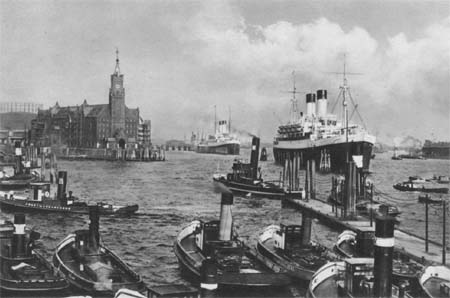
Monte class at Hamburg (old card, coll. WS)
|
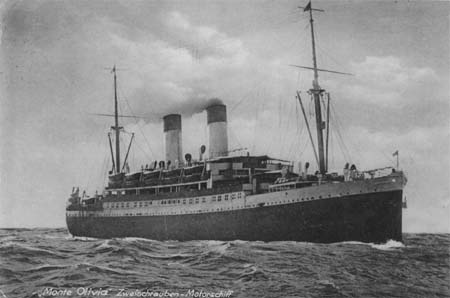
"Monte Olivia" (old card, coll. WS)
|
In the endeavour to maintain the leading position on the South Atlantic, the Hamburg-Sued awarded Blohm & Voss with the construction of a 25,500-ton de-luxe liner, which was christened on the name "Cap Arcona" (II). This most impressive three-funnel double-screw turbine ship went on 27 November 1927 on her maiden voyage to the River Plate. Appointments were provided for 1,315 passengers in three classes, the First being furnished with extraordinary splendour. Every cabin was fitted with a bath room. As the company's new flagship and premier liner on the South Atlantic, the "Cap Arcona" won great popularity with the public. Her turbines gave her a traveling speed of 20 knots (max. 21 knots) to cover the route to Rio de Janeiro via Boulogne, Vigo, Lisbon and Santos within 12 days, and after three other days she called at Montevideo and docked at Buenos Aires, being the fastest ship to these destinations. Four years after starting operation, her glory was overshadowed by the appearance of "L' Atlantique" of the Sud-Atlantique in 1931. This modern three-funnel liner surpassed the German premier ship as well in dimensions (42,212 tons) as in comfort. But the French triumph lasted no longer than 15 months, then "L' Atlantique" was destroyed by fire. The "Cap Arcona" regained however her former top position only for a short time. After the Italian star liners "Rex" and "Conte di Savoia" had been placed in service on the North Atlantic in 1933, they set free the "Augustus" and "Roma" to be transferred to the Genoa - River Plate route, superseding once again the "Cap Arcona" as the biggest ship of the South Atlantic. Out of season the "Cap Arcona" was much estimated for her regular cruises to scenic sites of the world.
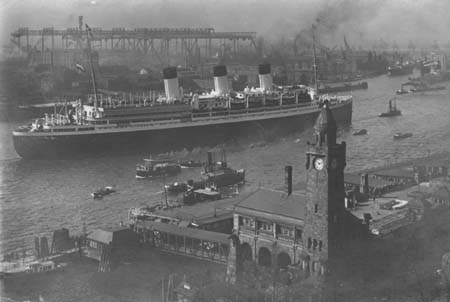
"Cap Arcona", departure at Hamburg (old card, coll. WS)
|
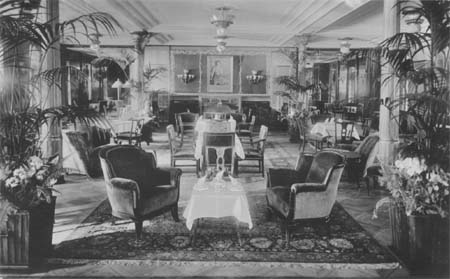
"Cap Arcona" (official card, coll. WS)
|
During World War II the "Cap Arcona" was used as a hulk for navy personnel at Gotenhafen (now Gdynia, Poland). In 1942 she put the stage for the anti-British propaganda film "Titanic". Nonetheless, scenes of this film were later taken over by a British producer for the film "A Night to Remember". When in January 1945 the Red Army approached the German frontiers, the ship was re-activated for the evacuation of refugees. In three operations she brought about 26,000 persons to safety. In April 1945 the ship had - against the protest of the ship command - to take on board 7,500 prisoners of concentration camps with their SS-guards while mooring in the Bay of Neustadt near Luebeck together with other civil ships. Until today, nobody knows about the intentions about these ships. The conditions on board of the overcrowded ship had become unbearable. To avoid epidemics, 2,000 French prisoners were released. Then, five days before the end of hostilities, one of the greatest tragedies at sea took its course. Nine British fighter bombers attacked the ships and set them on fire, producing panic and an indescribable chaos. Only about 500 prisoners survived that hell by swimming on land, others were shot at flight yet on shore. Possibly, the Air Force command thought of a troop transport. Five days later, the British troops arrived at the capsized wreck, which had once been Germany's pride on the South Atlantic.
Let us once more go back into 1930s. In the year 1930 Norddeutscher Lloyd acquired a 60 percent share in the Hamburg-Sued. What the company urgently needed, were smaller vessels for an economic operation. To come up to this demand, some ships were chartered in 1934 and later purchased from the Hapag, as there were the "General Osorio", a 11,590-ton motor ship of 1929, operating at 15 knots and carrying 980 passengers in Second and Third Class facilities (during the war she received bad damages in an air attack when mooring as a hulk in Kiel and was wrecked down in Scotland). Other acquisitions were the "General Artigas" (sharing the same fate) and the "General San Martin", built in 1922,each of similar dimensions (fitted out as a hospital ship in 1945 and operating as a troop transport "Empire Deben" for Shaw, Savill & Albion after the war on order of the Ministry of Transport, until being scrapped in 1949).
Norddeutscher Lloyd (NDL)
Apart from the Hamburg-Sued company as the leading shipping enterprise to the South American east coast, yet other German companies showed interest to participate in the promising business. Having passed a deep economic crisis, Norddeutscher Lloyd initiated in 1875 monthly departures from Bremerhaven via Antwerp and Lisbon to destinations in Brazil and the River Plate ports with four 3,000-ton steamers, the "Hohenzollern", "Salier", "Habsburg" and "Hohenstaufen" with facilities for 800 steerage passengers and 142 in the 3rd Class. In 1895 they were re-transferred to the New York route, where they had been coming from. A sad end found the "Salier" having run aground off-shore the north-Spanish coast in 1896 with 280 victims. In 1889 the NDL had taken delivery from Fairfield of Glasgow the 3,300-ton "Muenchen" and "Dresden". With their passenger capacity of 1,800 in two steerage decks and only 38 in the cabin classes, they were provided for the emigrant transport. While the "Muenchen" changed the same year onto the North Atlantic, sister "Dresden" continued her River Plate service with some interruptions until 1903.
From 1912 four ships of the Sierra class were introduced. Among the Sierra steamers of NDL, the 8,800-ton "Sierra Salvada" of 1913 had a confusing career: Requisitioned during WWI in Brazil, she became the "Avare", from 1923 she was cruising as "Peer Gynt", "Neptunia", then "Oceana" for Hapag, then for KdF, and she ended as "Sibir".
In 1924 the NDL assigned onto the Bremerhaven - South America itinerary the "Sierra Ventana", "Sierra Cordoba" and "Sierra Morena", double-screw two-funnel steamers of 11,500 tons, carrying about 2,000 passengers in 1se, 3rd and steerage accommodations, averaging 14 knots. Apart from their route operation, the ships were also used for cruises. In 1930 the NDL entered into a contract with the Koninglijke Hollandsche Lloyd to remain firm against the mighty South America operators. Then, in 1934, the entire German ocean-going shipping had to be reorganized on order of the government. The NDL and the Hapag entered into an operational union and retired from their South American east coast operations, which were exclusively left to the Hamburg-Sued. The above-mentioned Lloyd steamers were refurbished to single class ships with a few de-luxe cabins for selected guests. They were sold the following year to DAF for the KdF organization in the hands of the nazi party to take people of the working classes at very low costs on recovery cruises.
The "Sierra Nevada", renamed "Madrid", was acquired by the Hamburg-Sued in 1934. In 1940 she broke through the British blockade and reached St. Nazaire. The following year she was sunk in an air attack off-shore Den Helder, Netherlands. The "Sierra Ventana" sailed occasionally to Central America and New York, before she was sold to the 'Italia' group in 1935 as "Sardegna". The "Sierra Cordoba" suffered heavy damages in the war (while towing the wreck away to Scotland for scrapping in 1948, she teared-off and sank off-shore Jutland). Between 1932 and 1934 the Hamburg-Sued liner "Cap Norte" (19,221 gt, 13 knots) operated on charter for the NDL on the River Plate route, becoming the second "Sierra Salvada".
Hapag
To avoid a conflict with the Hamburg-Sued, Chief Manager Ballin of the Hapag mediated in 1900 an agreement for a traffic share to two thirds for the Hamburg-Sued and one third to the Hapag by operating in a common schedule. With taking delivery of the 3,000-ton "Amazonas", the Hapag initiated a passenger service to Buenos Aires in 1904, which was extended as far as further tonnage would have been available: "Novarra" (5,779 gt), "Salamanca" (5,970 gt), "Corcovado", "Ypiranga" (8,000 gt each), "Valesa" and "Valencia" (5,200 gt each), plain designed single-screw steamers, mainly provided for emigrant transport, entering the line between 1906 and 1913. After some time they were transferred to other routes.
In 1920 Hapag placed in service the "Prinz"-class on a Rio de Janeiro route: "Prinz Waldemar", "Prinz Adalbert", "Prinz Oskar" and "Prinz Sigismund". These single-screw ships of about 6,000 tons were tropicalized and operated at 12.5 knots. After a few years they changed to other routes, mainly with Central American destinations. To compensate war losses and reparation deliveries, the Hapag repurchased the "Habsburg" (renamed "Teutonia"), "Thessalia" (renamed "Galicia") and "Rugia", plain single-screw cargo/passenger steamers of pre-war design, intended to resume South America operations in 1921. First newbuilds were placed in service in 1922 as "Country"-class, comprising three units of about 8,000 tons: "The "Baden" was rebuilt in 1935 into a pure cargo ship, "Sachsen" was sold in 1936 to the Hamburg-Sued, "Hessen" operated temporarily on the New York and on the East Asia route until she was employed on the South American west coast itinerary. In 1929 the Hapag placed on the River Plate route the remarkable double-screw motor ship "General Osorio" of 11,590 tons, managing 15 knots. With the award of the entire competence for the South American west coast passenger trade to the Hamburg-Sued due to the shipping reorganization, the "General Osorio" was sold to that company in 1936 together with a number of other vessels of the Hapag.
To South America's West Coast
Destination ports with minor volume of passenger traffic have usually been met with cargo ships accommodating less than 12 berths, which were freed from the International Passenger Certificate. This had been the case with ports on South America's west coast. Until the opening of the Panama Canal in 1914, the itinerary led round the southern promontory of the subcontinent through the Magellan Strait, notorious for its unfriendly climate conditions. From 1935 all passenger services there were assigned exclusively to the Hapag, which in compensation let the North and Central American west coast operations to the Lloyd. Both companies operated these itineraries with medium-sized modern passenger-cargo ships. The Hapag allocated its last two 8,300-ton turbine steamers of the single-screw "San Francisco"-class, fitted with 25 comfortably appointed First and Second Class cabins. One of them, the "Tacoma", was requisitioned at Montevideo in 1942, then chartered to the U.S. Maritime Commission, after WW II returned to Uruguay and operated, always under her original name, to European destinations (in 1969 she was used as a prison hulk and was broken up in 1986). Her route companion "Vancouver" was sunk in 1939 by sabotage, however raised and repaired. Requisitioned by the Dutch authorities at Curacao in 1940, she was renamed "Curacao", later in 1946 "Duivendyk, added to the Holland America Line and broken up in 1959. Launched in 1935 as "Hermonthis" for the NDL, a 4,800-ton motor-ship, berthing 20 First Class passengers, went one year later into the ownership of the Hapag. Making a start to break through the British blockade in 1941, she was sunk by the Canadian auxiliary cruiser "Prince Henry" off-shore Calao, Peru. Three other passenger-cargo ships, launched in 1938 for the Hapag, berthing 28 First Class passengers, operated at 15 knots on the Hamburg - Valparaiso route, were the medium-sized "Monserrate" (5,578 tons), the "Osorno" and the "Huascaran" (6,900 tons each). The first one was requisitioned by the Peruvian government in 1941. From 1947 she sailed for civil duties until the 1960s. The second one was surprised from war at Talcahuano, in 1941 transferred to Bordeaux (in 1944 she was self-sunk in the Gironde mouth). The third one was used from 1939 as a workshop ship of the navy. Handed over in 1945 to Canada and rebuilt into an emigration ship named "Beaverrae", she went in 1954 as "Aurelia" to the Cogedar Line and in 1970 as the cruise ship "Romanza" to the Greek Chandris line. The provided employment of the 21,500-ton three-funnel liner "Admiral von Tirpitz" (the later "Empress of Australia" of the Canadian Pacific) using the Panama Canal remained unrealized.
The most remarkable ship of this operation field was the 16,600-ton "Patria" of 1938, the first diesel-electric powered vessel in the world. Her double-screw drive gave her a speed of 17 knots and her extraordinary tropicalized comfort was equal to that of many modern North Atlantic liners. Starting life with two Northland cruises, she made her maiden voyage from Hamburg to Talcahuano. From 1940 she was used as a floating power station at Stettin, then transferred to Flensburg to be made a hulk for navy personnel. After Hitler's suicide, she became the residence of the last German war government under Grand Admiral Doenitz. On 1st July 1945 the ship was requisitioned by the British Military Government. Refitted to a troopship for the Ministry of Transport at Harland & Wolff and renamed "Empire Welland", she was handed over to the Soviet Union in February 1946, intended to operate as "Rossiya" to New York.
The largest units of Norddeutscher Lloyd to serve the South American west coast were the 9,179-ton double-screw passenger-cargo motor ships "Weser" and "Elbe", built in 1929 as "Sudamericano" and "Sud Expreso" for the Linea Sudamericana of Oslo, Norway. They were acquired by the NDL, which had them refitted to be employed on a Bremen - Vancouver route in 1934. Seven "City"-class motorships of some 5,000 tons were placed on the route between 1935 and 1939: "Osnabrueck", Duesseldorf" (captured by HMS "Despatch" off-shore Chile), "Nuernberg", "Muenchen" (failed a British blockade breakthrough, set on fire by the crew and sunk by the Peruvian cruiser "Almirante Grau" in 1941), "Dresden" (self-sunk at Bordeaux in 1944), "Leipzig" (self-sunk off-shore Calao in 1941) and "Hannover" (captured by a Canadian destroyer in 1940 and sunk as auxiliary aircraft carrier "Audacity" near Cape Finisterre by a German submarine).
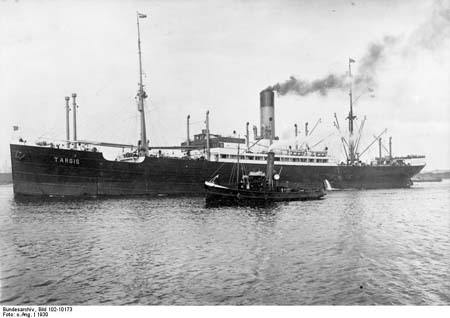 "Targis" of NDL, West Coast of South America (Bundesarchiv Bild 102-10173, via Wikimedia)
"Targis" of NDL, West Coast of South America (Bundesarchiv Bild 102-10173, via Wikimedia)
Kosmos
Apart from the prominent German shipping enterprises Hamburg-Sued, Hapag and North German Lloyd, another German operator arose in the South American west-coast trade: the Deutsche Dampfschiffahrtsgesellschaft Kosmos, founded in 1872 by ship agents together with a sailing-ship owner of Hamburg. Yet the same year the "Karmak", a small 1,268-ton steamer with auxiliary sails, went on her maiden voyage round Cape Horn to Chile and Peru, followed by sister "Theben" late the same year. Seventeen other small steamers of the Kosmos fleet, measuring 1,700 to 2,600 tons, operated as mixed cargo/passenger ships. An advanced delivery, measuring 2,800 to 3,800 tons, entered the fleet between 1890 and 1895.
In 1896 the ship-owner Adolph Kirsten set up the Hamburg-Pacific-Steamship Line and started a fierce competition to the Kosmos Line with his advanced passenger-cargo ships and forced his rival into a pool operation. Both companies ordered new tonnage in the late 1890s. The Kosmos Line took delivery of eight 4,600 to 5,000-ton steamers, the Hamburg-Pacific of 6 ships of 3,000 to 4,800 tons. The pool operation however got stuck in controversies. Under the influence of Hapag's General Manager Albert Ballin, who was chairman of the board of directors of each company, the Hamburg-Pacific Line decided its liquidation in 1898 and its 12 ships were taken over by the Kosmos Line, which extended its operation field as far as San Francisco and Vancouver. At the zenith of its development before World War I, the company disposed upon a cargo and passenger fleet of about 183,000 tons. Ports of call of the weekly departures for Chile and Peru were Antwerp, London, Genoa, Barcelona and Cadiz. An economic setback forced to sell the modern 6,000-ton mail steamers "Edfu" and "Esna" to Deutsche Ost-Afrika-Linie in 1910 and to abolish the Second Class. At the same time, new 7,000-ton passenger-cargo ships with 14 First Class berths were given on order.
Owing to the peace terms of the Versailles Treaty the Kosmos Line has lost all its tonnage. Economic difficulties forced to enter into a merger contract with the Deutsch-Austral und Kosmos-Linien of Hamburg. The ships of both companies received a new funnel-trademark in black/white/red, but each partner retained its own house flag. Until 1926 the Kosmos repurchased three pre-war ships from England and took delivery of eight new medium-sized passenger-cargo steamers working at 10 to 13 knots. Deutsch-Austral-Kosmos integrated the Hugo-Stinnes Linie with 24 ships augmenting the concern's tonnage to 354,700 tons, making it the third-largest shipping enterprise of Germany. The business however did not develop well. The Hapag realized that opportunity and entered into negotiations, which led to the incorporation of the Deutsch-Austral-Kosmos Linie. This way, the Hapag rose in one go again to one of the mightiest shipping companies - in the world. At this occasion the new funnel trade mark of yellow with black/white/red top was introduced in 1927, becoming a worldwide sign to be recognized by. The same year, the ex-Kosmos "Itauri" made its debut voyage through the Magellan Strait to the South American west coast already under the Hapag flag.
After World War II
After the German merchant fleet had been lost completely, the first new vessels for the Hamburg-Sued successor after WWII were two 7,000-ton motor-ships, commissioned in 1950. The "Santa Ursula" and "Santa Elena" were followed by other newbuilds. In the '60s historian Curt Frick listed (in 'Passagierschiffe und Autofaehren der Welt') for the Suedamerikanische Dampfschiffahrts-Gesellschaft of Eggert & Amsinck together with R.A. Oetker as the oldest vessel the "Cap Salinas", ex "Santa Catarina" of 1950, a 7,154-ton passenger-cargo motor-ship, accommodating 28 First-Class passengers. The motor ship "Cap Blanco" (1955/5,899 gt) and two sisters as well as the "Cap San Marco" (1961/9,828 gt) and four consorts were freighters with accommodation for only 12 passengers. All these ships were employed on a Hamburg - Buenos Aires route with the remark: "The European and South American ports-of-call are varying as required". Towards the end of the '70s the ABC Shipping Guide showed not any German regular South Atlantic service.
Literature: J. Cooper, A. Kludas, J. Pein: The Hamburg South America Line.
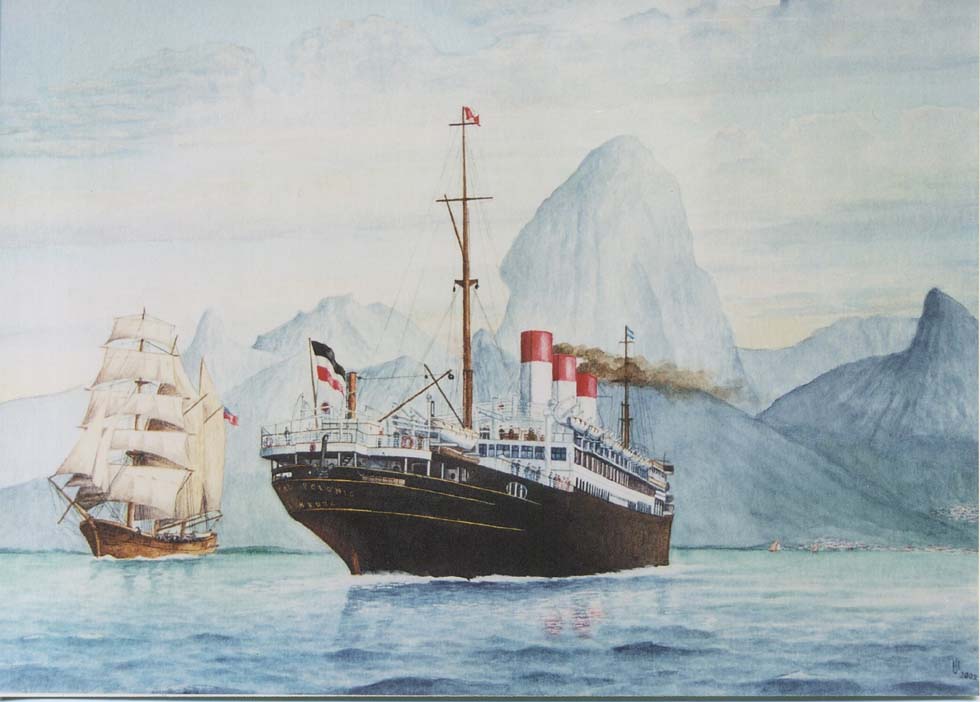
"Cap Polonio", entering the Bay of Rio de Janeiro (painting by Heribert Schroepfer)
|